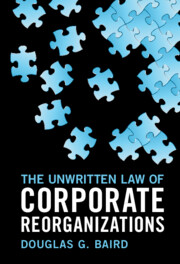25 results
Dedication
-
- Book:
- The Unwritten Law of Corporate Reorganizations
- Published online:
- 05 May 2022
- Print publication:
- 26 May 2022, pp v-vi
-
- Chapter
- Export citation
Contents
-
- Book:
- The Unwritten Law of Corporate Reorganizations
- Published online:
- 05 May 2022
- Print publication:
- 26 May 2022, pp vii-viii
-
- Chapter
- Export citation
5 - Priority Matters
-
- Book:
- The Unwritten Law of Corporate Reorganizations
- Published online:
- 05 May 2022
- Print publication:
- 26 May 2022, pp 91-107
-
- Chapter
- Export citation
Preface
-
- Book:
- The Unwritten Law of Corporate Reorganizations
- Published online:
- 05 May 2022
- Print publication:
- 26 May 2022, pp ix-xiv
-
- Chapter
- Export citation
1 - Badges of Fraud
-
- Book:
- The Unwritten Law of Corporate Reorganizations
- Published online:
- 05 May 2022
- Print publication:
- 26 May 2022, pp 1-21
-
- Chapter
- Export citation
Copyright page
-
- Book:
- The Unwritten Law of Corporate Reorganizations
- Published online:
- 05 May 2022
- Print publication:
- 26 May 2022, pp iv-iv
-
- Chapter
- Export citation
3 - The Credit Men
-
- Book:
- The Unwritten Law of Corporate Reorganizations
- Published online:
- 05 May 2022
- Print publication:
- 26 May 2022, pp 46-62
-
- Chapter
- Export citation
2 - A Seat at the Table
-
- Book:
- The Unwritten Law of Corporate Reorganizations
- Published online:
- 05 May 2022
- Print publication:
- 26 May 2022, pp 22-45
-
- Chapter
- Export citation
7 - Bargaining After the Fall
-
- Book:
- The Unwritten Law of Corporate Reorganizations
- Published online:
- 05 May 2022
- Print publication:
- 26 May 2022, pp 130-164
-
- Chapter
- Export citation
Afterword
-
- Book:
- The Unwritten Law of Corporate Reorganizations
- Published online:
- 05 May 2022
- Print publication:
- 26 May 2022, pp 184-185
-
- Chapter
- Export citation
4 - A New Deal
-
- Book:
- The Unwritten Law of Corporate Reorganizations
- Published online:
- 05 May 2022
- Print publication:
- 26 May 2022, pp 63-90
-
- Chapter
- Export citation
Index
-
- Book:
- The Unwritten Law of Corporate Reorganizations
- Published online:
- 05 May 2022
- Print publication:
- 26 May 2022, pp 186-188
-
- Chapter
- Export citation
6 - A Thumb on the Scale
-
- Book:
- The Unwritten Law of Corporate Reorganizations
- Published online:
- 05 May 2022
- Print publication:
- 26 May 2022, pp 108-129
-
- Chapter
- Export citation
8 - Looking for Runway
-
- Book:
- The Unwritten Law of Corporate Reorganizations
- Published online:
- 05 May 2022
- Print publication:
- 26 May 2022, pp 165-183
-
- Chapter
- Export citation

The Unwritten Law of Corporate Reorganizations
-
- Published online:
- 05 May 2022
- Print publication:
- 26 May 2022
10 - The Boilerplate Puzzle
-
-
- Book:
- Boilerplate
- Published online:
- 02 December 2009
- Print publication:
- 21 May 2007, pp 131-142
-
- Chapter
- Export citation
Legal Approaches to Restricting Distributions to Shareholders: The Role of Fraudulent Transfer Law
-
- Journal:
- European Business Organization Law Review (EBOR) / Volume 7 / Issue 1 / March 2006
- Published online by Cambridge University Press:
- 21 June 2006, pp. 199-215
- Print publication:
- March 2006
-
- Article
- Export citation
22 - The uneasy case for corporate reorganizations
-
-
- Book:
- Corporate Bankruptcy
- Published online:
- 10 December 2009
- Print publication:
- 29 March 1996, pp 336-350
-
- Chapter
- Export citation
9 - Bargaining after the fall and the contours of the absolute priority rule
-
-
- Book:
- Corporate Bankruptcy
- Published online:
- 10 December 2009
- Print publication:
- 29 March 1996, pp 113-140
-
- Chapter
- Export citation
4 - A world without bankruptcy
-
-
- Book:
- Corporate Bankruptcy
- Published online:
- 10 December 2009
- Print publication:
- 29 March 1996, pp 29-38
-
- Chapter
- Export citation



